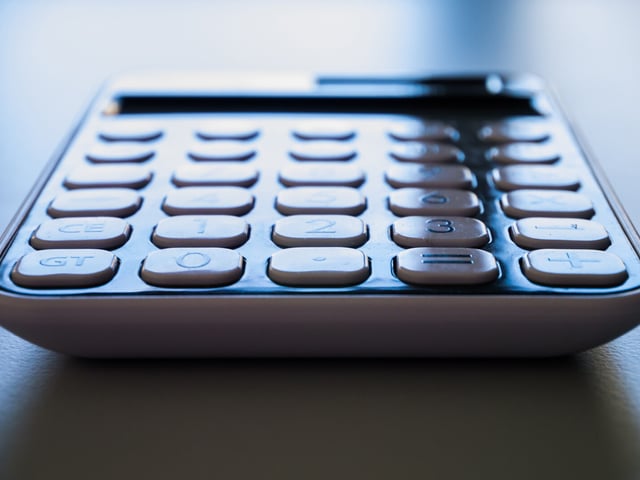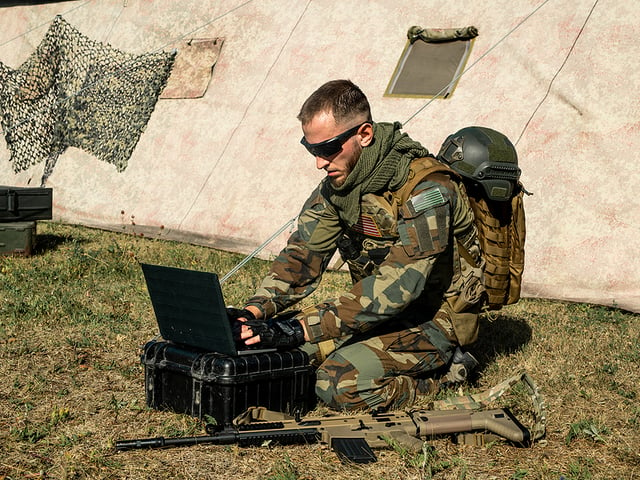
Can You Use a Calculator on the ASVAB?
Are you prepared to take the Armed Vocational Aptitude Battery (ASVAB) test? Over 1 million people take the ASVAB per year, either through their high school or a military recruiting process.
“Can you use a calculator on the ASVAB?” is a common question test-takers routinely ask. We answer this question and more in our ASVAB preparation guide.
Can You Use a Calculator on the ASVAB?
The answer to this question is “No.” Calculators are not allowed for either the pen and paper version or the computer version.
Other prohibited items include:
-
Cell phones
-
Portable music players (iPods, Walkmans, etc.)
-
Personal pencils, pens, and paper (these will be provided by the testing center)
-
Drinks or snacks
-
Note sheets or note cards
-
Backpacks or handbags
The ASVAB is essentially a closed-book exam. You aren’t allowed to bring any personal items into the testing center.
The testing center will not provide a calculator, either, although you are permitted to use the scratch paper they give you. You can use this paper to manually complete any calculations you need to answer a math question.
Why Aren’t Calculators Allowed?
The no calculator policy may seem harsh in today’s technology environment, where everyone carries around a calculator thanks to their cell phone. There are also many career, college, and entrance exams that permit the use of a calculator.
Why is the ASVAB different? The ASVAB is an aptitude test. This is a very distinct testing format from the achievement tests most people become familiar with during grade school.
How is the ASVAB Different From Other Exams?
An achievement test measures what you’ve learned in your academic career. This includes standardized academic benchmarks such as a “9th-grade reading level” or “early college math.”
An aptitude test measures your abilities and skills. Scores are based on the aptitudes you demonstrate, such as:
-
Language abilities
-
Analyzation skills
-
Arithmetic reasoning
-
Math skills
-
Spatial skills
-
Mechanical and electrical abilities
This aptitude measurement helps the military determine what career development paths are the best fit for you. It can show whether you’re best suited to be an aircraft mechanic, for example, or a hospital corpsman.
It also helps high school students with their career exploration before choosing a college, trade school, or military branch. They can figure out where their interests and abilities lie before making a major education or career commitment.
If you use a calculator on the ASVAB, it won’t help you measure your actual mathematical aptitude. Military service members are also required to have essential skills to fall back on for critical, high-stress situations.
What is the ASVAB’s Test Format?
The ASVAB can either be completed by bubble sheet exam, or by using a computer. The pencil and paper version is called the P&P ASVAB or the traditional ASVAB. The computer version is referred to as a CAT-ASVAB.
Most high schools use the traditional P&P version, while the military generally uses the computer format. You can ask your school guidance counselor or military recruiter if you aren’t sure which format you’ll be using.
The ASVAB test format affects your testing strategy. For example, you cannot skip questions on the CAT-ASVAB, although you can on the paper exam.
The P&P ASVAB Test
For this version, you test each section separately at specific intervals. You can not go back and revisit previous sections once you finish a section. You can skip around and revisit questions within the section before the timer ends.
In a military recruiting center, you must wait for the next section until it’s given to everyone. You also can’t leave until everyone finishes the test. This means the testing process can take up most of the day.
There is no penalty for guessing or getting answers wrong on this ASVAB version. Incomplete questions will be marked wrong, so it’s a better strategy for your ASVAB scores if you make an educated guesstimate rather than leave the question blank.
The CAT-ASVAB
The CAT-ASVAB is an adaptive test. Once you answer a question, the next questions will be based on how well you did on the previous questions.
A wrong answer will lower the difficulty of the next question. A right answer will increase the difficulty. This gives the ASVAB a more precise gauge into the range of your abilities and skills.
There are penalties for guessing on this test, as it will affect your next questions. You cannot skip around the section or the questions. Once the section is complete, you can move on to the next section without waiting.
ASVAB Test Sections
Both ASVAB versions have nine main sections:
-
General Science (GS)
-
Arithmetic Reasoning (AR)
-
Word Knowledge (WK)
-
Paragraph Comprehension (PC)
-
Mathematics Knowledge (MK)
-
Electronics Information (EI)
-
Auto and Shop Information (AS)
-
Mechanical Comprehension (MC)
-
Assembling Objects (AO)
The CAT-ASVAB breaks down Auto and Shop Information into two separate sections, Auto Information (AI) and Shop Information (SI). The testing material remains essentially the same, however.
How Do You Score Well on the Math Sections Without a Calculator?
Are you worried about the math sections? It may seem intimidating to attempt complex math questions without a trusty calculator. But even people who aren’t naturally math-savvy can do well with the right preparation.
This includes familiarizing yourself with the test format and the subject material that will be covered in the test’s questions. It also means using effective study methods and tools.
Arithmetic Reasoning
The Arithmetic Reasoning section measures how you use your math skills to solve problems. This includes knowing the appropriate formulas and calculations to find the correct answer to a word problem.
You’ll have to hone certain math abilities for this section. These include:
-
Using math buzzwords to determine the right calculation method
-
Selecting the relevant numbers and information
-
Analyzing paragraph format to find an appropriate equation
You’ll also need basic knowledge in many math-related areas, such as:
-
Basic arithmetic definitions (whole numbers, integers, etc.)
-
Basic properties of numbers (associative, commutative, and distributive)
-
Rules of operations
-
Fractions and decimals
-
Exponents and radicals
-
Scientific notation
-
Measurement (including the metric system)
-
Geometry
-
Working with data (averages, outliers, etc.)
-
Probability and rates
This seems like a long list, but don’t despair. The test section is relatively short:
-
P&P ASVAB: 30 questions in 36 minutes
-
CAT ASVAB: 16 questions in 39 minutes
This gives you around 1-2 minutes to answer each question. You can use practice tests to gauge your manual calculation speed and see where you need improvement. Practice tests also have the added perk of reducing test anxiety.
Mathematics Knowledge
The Mathematics Knowledge section covers your knowledge of algebra and geometry, along with the skills you used in Arithmetic Reasoning. This means you’ll need to know subjects such as:
-
Algebraic expressions and terms
-
Types of expressions (monomials, binomials, and polynomials)
-
Simplifying and evaluating expressions
-
Factoring
-
Equations and inequalities
-
Quadratic equations with variables
-
Geometry terms and expressions
-
Geometry calculations (perimeter, square footage, etc.)
This test section is also shorter than the AR section:
-
P&P ASVAB: 25 questions in 24 minutes
-
CAT ASVAB: 16 questions in 20 minutes
This may seem like less time per question, but you’ll also have more general knowledge questions vs. complex word problems. In addition to practice tests, you can use flashcards and study the appropriate math formulas you’ll need.
You may not want a math-intensive career, so it can be tempting to skimp on studying for these sections. You still need to score well on these sections, however.
How is the ASVAB Scored?
The ASVAB is not a pass/fail test, so ultimately there is no penalty for wrong answers. Your scores have two important measurements as a military test, however:
-
Enlistment eligibility
-
Career choice
Your ASVAB scores in each section determine certain composite scores. If you score low in the math sections, it can negatively affect these composite scores.
Enlistment Eligibility Scores
You need a minimum score to enlist in the military. This is referred to as your Armed Forces Qualification Test (AFQT) score. Your AFQT score is a combination of four ASVAB test sections:
-
Arithmetic Reasoning (AR)
-
Mathematics Knowledge (MK)
-
Paragraph Comprehension (PC)
-
Word Knowledge (WK)
The AFQT score is based on a percentile, ranging from 1% (lowest) to 99% (highest). This is not directly based on how many questions you get correct, but on how your performance scored against an average.
If you score a 60%, for example, this means you did better on the ASVAB than 60% of the sample group. It does not mean you answered 60% of the questions correctly out of 100.
AFQT minimums vary by military branch, and are frequently subject to change as enlistment quotas increase or decrease. The current minimums are:
-
Air Force: 36
-
Army: 31
-
Coast Guard: 36
-
Marine Corps: 31
-
Navy: 35
These requirements are higher if you use a high equivalency exam, such as the GED or HiSET test. The Army AFQT minimum, for example, increases from 31 to 50.
Career Choice
Military training is expensive and time-consuming. The Department of Defense wants to make sure they match the right recruits with the right career development.
Each branch has its own rating criteria for career choices. The Army, for instance, uses line scores to determine what career choices you’re eligible to enlist in.
To qualify as Field Artillery, your line score uses your performance in the AR+CS+MK+MC sections. A General Technician, by contrast, only uses VE (WK+PC) and AR.
This process can be confusing at first glance. Your military recruiter can help you determine what ASVAB scores you need for your potential military branch and career choices.
Overcome the Obstacles in Your Path and Sign Up Today!
While the answer to “Can you use a calculator on the ASVAB?” is a negative, this factor doesn’t have to stop you from performing well on the ASVAB test. The military looks for candidates who know how to prepare for adversity and overcome obstacles. Show them you have what it takes by mastering the ASVAB!
If you need more tools and tips to master the ASVAB, we have you covered. We offer a wealth of lesson plans, study guides, and other test-taking support. Check out our free resources today!
Keep Reading

Armed Services Vocational Aptitude Battery Blog
What is the ASVAB Test?
The Armed Services Vocational Aptitude Battery, known as the ASVAB, is …

Armed Services Vocational Aptitude Battery Blog
Military MOS Codes
Military Occupational Specialty (MOS) codes are an integral part of the…

Armed Services Vocational Aptitude Battery Blog
U.S. Army Height and Weight Standards for Females
The U.S. Army’s commitment to maintaining a robust, physically fit, and…